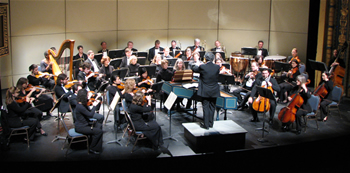What is American music? Is Beethoven American? What about hip hop and the blues? Is it historic or contemporary or both? Can we call the string quartet American? The Grammy-nominated PUBLIQuartet explored the multitude of possibilities raised by these questions through their performance of featured works from their 2016 concept album justly titled, What is American? The thoughtfully curated program included classical compositions for string quartet, contemporary works, reinventions of American popular music, and a generous helping of improvisation. Looking into the kaleidoscope of American musical genres through the eyepiece of the string quartet, I felt my perception colored by three distinct lenses.
The first of these three lenses tinted over the eyepiece was nature. Outside on a warm and crystal-clear day, PUBLIQuartet opened the instrumentation of the quartet to include the music naturally occurring around us at Harold D. Ritter Park. For the first piece, improvisations on Antonín Dvořák’s “American” Quartet (Op. 96), the music of nature was a featured guest. The sound of creaking, wind-worn branches echoed alongside cello and viola while twittering birds and gentle breezes whirled and whistled with the violins as if setting the scene for Dvořák. During his time as director of the National Conservatory of Music of American in New York, Dvořák was greatly inspired by the tradition of black spirituals and worked with his colleague and friend Harry T. Burleigh to learn from this tradition. Dvořák, however, didn’t spend all his time abroad in New York. In the summer of 1893, Dvořák left New York for Spillville, Iowa, a tiny town in the Midwest with a large population of Bohemian immigrants. There, Dvořák found his muse rolling with the hills. It was there in Iowa where Dvořák wrote the “American” Quartet and made significant progress on his Symphony No. 9 “From the New World.” Channeling Dvořák’s natural inspiration, PUBLIQuartet’s initial preface to the quartet left a lasting impression on the whole concert. Every moment of silence, every transition, every pianissimo whisper was accompanied by the sound of the bugs, the birds, and the branches, all warmed by spring.
Of course, a musical telling of American is history is incomplete without a serious consideration for the lens of race. Without tokenizing or reducing the works to just a “diversity concert,” the entire program considered the way Blackness especially is an interwoven thread in American musical legacies. The piece, At the Purchaser’s Option by Rhiannon Giddens, was the cornerstone of this necessary consideration for race. Straight to the point, PUBLIQuartet violinist Jannina Norpoth explained Giddens impetus for the piece. Based on a 19th-century advertisement for a 22-year-old Black woman and her child, Giddens imagines this woman’s inner dialogue as she’s being sold. The advertisement states that she is remarkably smart and healthy and that her child of about 9 months is also available for purchase at the purchaser’s option. Pained and laborious, PUBLIQuartet began the piece with a defiantly breathy muttering of Gidden’s lyrics, “You can take my body, You can take my bones, You can take my blood, But not my soul.” Building and building in intense resentment and contempt, each member took a turn shredding on their instrument like an electric guitar in a classic rock band. Grungy, virtuosic, and insistent, the PUBLIQuartet performance of At the Purchaser’s Option was a testament to the resilience of the oppressed in the face of cruelty.
Adding the final lens, PUBLIQuartet included popular music as an integral part of American history. A touchy subject when it comes to classical music, popular music should be considered just as valuable, expressive, and socially important as other historical forms of music. PUBLIQuartet takes Daniel Bernard Roumain‘s Hip Hop Dances and Prayers just as seriously as Dvořák. In this program, the avant-garde is just as important as showtunes. Their convincing fluency in jazz, the blues, rock, and European art music shows the depth of PUBLIQuartet’s commitment to finding expression in every genre. And at the center of all of it, improvisation is just as treasured as a written score.
PUBLIQuartet is an exceptional joy to watch in live performance. I’ve seen plenty of string quartets that are dynamic and visually expressive but there was something so invigorating about watching PUBLIQuartet. What’s even more impressive is that there’s no mystery in the way they present themselves. They don’t hold their cards close to their chest; their creative process is transparent and they were so prepared to share with their audience the nitty gritty about how the music gets made – not a compromise to be seen. Every piece felt fresh, relevant, and connected to the story each member of PUBLIQuartet wants to tell.











